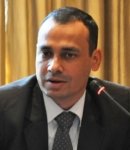Naxal Violence: Expanding into India’s Northeast?
17 Jan, 2013 · 3795
Bibhu Prasad Routray evaluates the success of the Naxalites’ twin objectives in the region
Ever since contact between the Communist Party of India-Maoist (CPI-Maoist) and an insurgent group operating in India's northeast was first established in 2006, the Naxalites have pursued twin objectives in the region. Firstly, the Northeast has been used as a transit route to ferry arms and other ammunition from China. Secondly, the region has also figured in the geographical expansion strategy of the extremists. What has been their success in these two objectives? Are they relatively more successful in their first objective than the second? Why?
For the CPI-Maoist, 2008 was a landmark year. In October that year, they issued a joint statement with the Manipur-based People's Liberation Army (PLA). Both reiterated their commitment to "consolidate the mutual understanding and friendship" and to "stand hand in hand to overthrow the common enemy". Intelligence agencies, however, maintain that the links between the two had been firmed up in 2006. Since then, and till 2011, the PLA assisted the Maoists in procuring Chinese arms and communication equipment via Myanmar. The PLA also provided training to the Maoists. A PLA leader, who had led a team of instructors to train Maoists in Jharkhand, was arrested in April 2012.
While the PLA fulfilled the crucial logistic requirements of the Maoists, it was Assam, bordering West Bengal, which figured prominently in the expansion plan of the CPI-Maoist. Interestingly, the operational weakness of the most prominent insurgent group in the state - the United Liberation Front of Asom (ULFA), served the Maoists’ interests well. According to intelligence sources, the Maoists first attempted to court fringe Adivasi groups in Assam. However, they had to settle for the ULFA since most of the Adivasi groups were, and still are, in the process of negotiations with the state. Assam's Police database on 150 Maoist cadres in the state includes many former ULFA cadres.
The willingness of the ULFA to play facilitator to Maoist strategies for the Northeast had become apparent in 2010. That year, ULFA Chief Paresh Baruah congratulated the Maoists for carrying out successful strikes on the security forces in Chhattisgarh's Dantewada. Again, in 2011, the ULFA extended its sympathy after senior Maoist leader Kishenji was killed in West Bengal. In May 2012, Baruah criticising the killing of four Maoist cadres in Assam, reiterated "We (the Maoists and the ULFA) may have different ideologies but we share a common quest. Our enemy is common and the Maoists have our complete moral support."
Interestingly, however, official assessments carried out by New Delhi and Assam till mid-2012, differed significantly on the issue of ULFA and Maoist linkages. In June 2012, the then Home Minister P Chidambaram, responding to increasing talks about a nexus between the Maoists and the ULFA, reiterated that the central agencies have no proof of such a linkage.
The Assam government, on the other hand, underlined the existence of such a nexus. In May 2012, the Assam Police declared to have created a database of 150 active Maoist cadres in Assam. A month later, Chief Minister Tarun Gogoi asserted, "Be it ULFA, be it NSCN-IM or be it (Manipur’s) PLA, every one has close links with the Maoists. We have no doubt about that.” Contradicting the then Union Home Minister's statement, the Chief Minister went on to assert, "He (Chidambaram) may have his own sources, but I have my own."
Subsequently, New Delhi fell in line and started supporting the Assam government's view point on the Maoists. In December 2012, Union Rural Development Minister Jairam Ramesh went to the extent of suggesting that the upper Assam districts- Dibrugarh and Tinsukia should be included in the list of Left Wing Extremism-affected districts.
While the debate over the attempts of the Maoists to find a foothold in Assam and the rest of the Northeast is more or less settled, the extent of their actual presence continues to be a matter of speculation. It is apparent that the Assam government is inclined to portray an alarmist description woven around Maoist fundraising, recruitment and plans for violence.
However, the fact remains that the expansionist quest of the CPI-Maoist in Assam is also a narrative of repeated setbacks and failures. In May 2012, for example, the four Maoists killed in Tinsukia district included the outfit's area commander Siddhartha Bargohain. Prior to that incident, over 60 Maoist cadres and over-ground workers had been arrested from several upper Assam districts. Recent media reports on 16 January 2013 indicated the arrest of Maoist central committee member Alok Bakshi in Visakhapatnam. Bakshi was in charge of the expansion plan of the Maoists in Assam. Therefore it can be reasonably concluded that, so far, the attempts by the Maoists to gain a foothold in the Northeast have been successfully dealt with.
This reality on the ground, as well as the sufficient awareness generated so far on the Maoist activities provides added advantage to the security establishment in Assam and other Northeast states to checkmate future LWE endeavours in the region. The Northeast has a substantial central force presence. The police in these states too, have sufficient counter-insurgency experience. The dip in insurgency-related violence in the region in recent years, further allows the police to concentrate its efforts on Maoist activities in the future.


